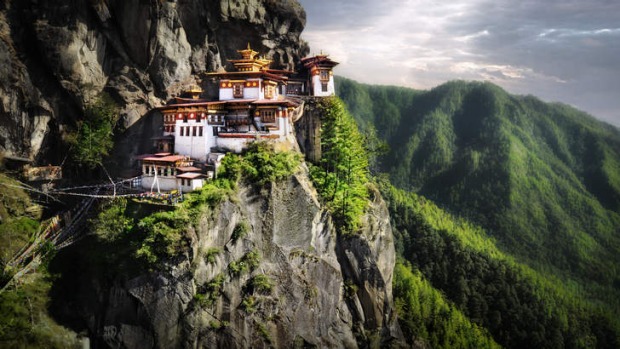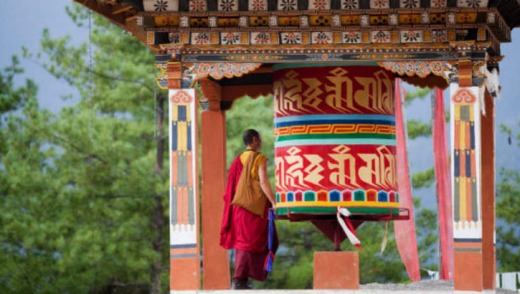
Gazing across the Himalayan vastness to Everest, Penny Watson discovers a vision splendid.
A trail of tread marks, hoof prints and horse droppings precede me as I trudge upward, the repeated patterns dotted with pine cones and criss-crossed with half-exposed tree roots. My shoes are covered with a thin patina of dust that won't settle until the weather turns. It should have snowed by now, a crisp layer of white putting locals at rest, dogs indoors and a season to bed, but alas, the mountain peaks of Bhutan are still green in mid-January.
It is to my advantage. The closest town of Paro is at 2280 metres and by rights I should either be freezing or wrapped in winter thermals; certainly I should be wearing gloves and a beanie. But the air is alpine fresh and clear, filling my lungs with goodness. It's also a brilliant blue-sky day - the kind that makes me want to sound my barbaric yawp over the rooftops of the world.

And soon I will. If not a yawp then perhaps an om mani padme hum, the ever-repeated Buddhist mantra. I'm on the "four- or five-kilometre" (nobody knows for sure) hike to Taktsang Goemba, or Tiger's Nest monastery, one of Bhutan's most sacred Buddhist temple complexes and one of this Himalayan country's most photographed attractions.
The monastery's old white-washed walled temples with their red and gold rooftops and decorated wood gables cling miraculously to a sheer cliff face that juts out at 3120 metres, 900 metres above the valley below. It's a sight that is reliably memorable. Photos or not, I'll keep this vision splendid with me for life.
But for now, I'll keep trudging. From the Paro Valley, the trail climbs steadily through blue pines and cypress, its boundaries narrowing here and widening there as it navigates the easiest route around trees, rocks and tricky terrain like a river. The track-side scenery, its winter aridity and pine tree ruddiness, reminds me of Yosemite National Park, but the similarity is easily forgotten when I cast my eye out into the void. The hazy blue peaks that disappear into the horizon are like lapping waves on a vast ocean, their intensity of a scale found only here in the Himalayas.

With an ascent of about 900 metres, this day hike is a must-do for any visitor to Bhutan, not merely because its ascending twists and turns have a habit of lining up the monastery above in picture-perfect frames. Such is the monastery's outlandish location, this trail is the only means of getting to it. There are no back-road entries or chairlifts, just this winding track, shared by fellow hikers and disconsolate mules that stumble along with the weight of older tourists, infirm pilgrims and cumbersome bags of butter used to fuel the temple lamps.
Slow and steady wins the race, I tell my guide Tshewang, who is bouncing up the trail as though he's done it a hundred times (he has). In deference to my slowness, he stops every now and then to point out birdlife (spotted nutcrackers, coal tits and eagles) and beasts (white langurs). He's also good for a story or two. Pointing to the highest peak on a ridge of mountains he tells me about the sky burials, where local people traditionally sacrifice their dead children to circling vultures. Beyond it, he says, is Jhomolhari Mountain, from where you can see Everest. The Jhomolhari trail, a nine-day affair with spectacular views of the 7314-metre mountain, is his favourite trek and Bhutan's most popular. It puts today's hike into perspective, and I pick up the pace.
As we climb higher the scenery changes. Maple trees, chestnuts and Himalayan oaks start to appear, their branches draped in pale green airborne lichen, which gives the forest, now darker and denser, an almost ghostly air. Prayer flags heighten the effect. While the coloured flags are particularly photo-friendly, it's the forgotten, faded white flags still wrapped around the undergrowth that are a more common sight up here, the torn and tattered text bringing to mind plastic flowers on a gravestone.

It takes about three hours to reach the 3300-metre mark, the highest point of our journey. Accomplishing the milestone with me is a seriously old couple, their faces tanned and creviced and their lips red from chewing betel nut. Tshewang translates their tale. They are on a pilgrimage from Eastern Bhutan, a journey that takes 12 days by road "unless you use the roads of neighbouring India and re-enter closer to home". Dressed in traditional gho and kera outfits and carrying carved hiking sticks, they are fulfilling a lifetime quest to visit this sacred place, their tiny frames trudging up the slope with the kind of intensity you see on marathon runners.
My visit is not so profound, but such is the Zen-like Buddhist calm of Bhutan, it feels meaningful nevertheless. I've signed up to a Himalayan Explorer cultural tour operated by Como Hotels. The five-night itinerary takes in the major sights and valleys of western Bhutan with three nights at Uma resort in Paro (where we visit Kyichu Lhakhang, Bhutan's oldest temple, and the fortress Rinpung Dzong), and two nights at the new Uma resort in Punakha (home of the famous Dochula Pass and the eccentric Temple of the Divine Madman). In between we have a day in the capital, Thimphu.
Though fleeting, my visit has afforded me an insight into Bhutan and its people without feeling like I'm merely ticking boxes. This is in large part thanks to my accommodation. Both Uma resorts are dedicated to relaxation conducive to a Buddhist ethos. Staff are monk-like in their attentiveness, the food is gourmet organic but unpretentiously so, and the rooms are like little temples themselves, with the "soul" purpose of immersing guests in comfort and ensuring a good night's sleep.
This is especially so at tiny nine-room Uma Punakha. Here, I eat breakfast on an outdoor deck that overlooks the Mo Chu River, and the steep hills rising from its banks. The first glint of sunlight lands on the sloping gold roof of a nearby temple. The combination of good food, sleep, setting and serenity has set me up nicely for hikes such as the one I'm on today.
From the highest point, the trail drops about 200 metres on a thin path to the temple. Halfway along, the spray from a waterfall streaming from an unseen point above ends in a huge mound of ice, another reminder that it should be colder. At the door to the monastery security relieves us of day packs and cameras; we are free to roam.
In the monastery's temples, colourful shrines explode with paintings and statues of mythical creatures, tantric beasts and historical figures that tell a strange, ethereal version of Bhutan's history and Buddha's part in it. I bow my head and clasp hands to my heart, but I confess my deity is to be found outdoors. From up here on the cliff face, the world falls away to the valley beneath me, the sky reaches endlessly high and the mountains stretch on forever.
As we descend, Tshewang points out cloud formations that hint at snow. Sure enough big white puffs start falling during the night. My plane is delayed the following morning but I've had my day in the sun, and now the people of Bhutan can finally rest for winter.
FIVE OTHER DAY HIKES IN SOUTH-EAST ASIA
Mount Batur, Bali, Indonesia
Eager hikers rise early for the steep ascent to the summit of Mount Batur (1717 metres), an active volcano with a scenic volcanic lake. Less-serious punters can appreciate the views from the town of Penelokan.
Shan Hills, Kalaw, Burma
A former colonial British hill station, the small community of Kalaw (1300 metres) is the base for plenty of cool-climate day-trekking opportunities to traditional villages in a rural setting.
100 Waterfalls Trek, Nong Khiaw, Laos
This adventurous hike opened to non-locals in 2008, and begins on the Nam Ou river. Continue on foot along small streams and rice paddies, up bamboo ladders and through stretches of a waterfall that cascades over two kilometres.
Mount Kinabalu, Borneo, Malaysia
More than 40,000 people a year tackle this 4095-metre massif in Malaysia's first UNESCO World Heritage site, and not everybody succeeds. It's a two-day affair.
Lao Chai and Ta Van village walk, Sapa, Vietnam
Cloud-shrouded mountain scenery, rice paddies and traditional Black Hmong hill tribe villages make this one of Sapa's most popular day walks.
FAST FACTS
Getting there Thai Airways has a fare to Bangkok for about $1180 return from Sydney and Melbourne (about 9hr 30min), including taxes; see www.thaiairways.com. The Bhutan national carrier, Drukair , operates daily flights from Bangkok to Paro, which depart early in the morning. Uma Paro is a 10-minute drive from Bhutan's only international airport.
Staying there Uma by Como's Himalayan Explorer itinerary costs $US5760 ($5625) a person for three nights double occupancy at Uma Paro and two nights at Uma Punakha (or $US4430 for single occupancy). The price is on a full board basis, which excludes beverages, but includes meals and picnics, excursions with English-speaking Bhutanese guide, transfers and transport in Bhutan, government visa fees, royalties and taxes, museum and visitor centre entry fees, one massage a person, and daily yoga classes.